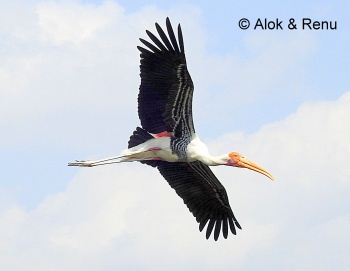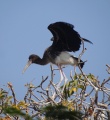m (→External Links: updated VSearch) |
|||
| (20 intermediate revisions by 7 users not shown) | |||
| Line 1: | Line 1: | ||
| − | + | [[Image:Painted_Stork.jpg|thumb|550px|right|Photo © by {{user|Sumit|Sumit}}<br />Kolkata, [[India]]]] | |
| − | [[Image:Painted_Stork.jpg|thumb|550px|right|Photo by Sumit]] | + | ;[[:Category:Mycteria|Mycteria]] leucocephala |
| − | + | ||
==Identification== | ==Identification== | ||
| − | + | [[Image:IMG 3447-Edit.jpg|thumb|350px|right|Juvenile<br />Photo © by {{user|daneshmanjula|daneshmanjula}}<br />Somawathiya National Park, [[Sri Lanka]], December 2018]] | |
| − | + | 93–102 cm (36½-40 in) | |
| − | + | *White overall plumage | |
| − | + | *Dark breast barring | |
| + | *Black flight feathers | ||
| + | *Red head | ||
| + | *Yellow, long, down-curved bill | ||
| + | *Pink tail and legs | ||
| + | Juveniles are similar to adults, but duller. | ||
==Distribution== | ==Distribution== | ||
| − | + | [[Asia]]: found in [[China]], [[Tibet]]<br /> | |
| − | + | '''South Asia''': [[Pakistan]], [[India]], Eastern [[Himalayas]], [[Sri Lanka]]<br /> | |
| + | '''Southeast Asia''': [[Indochina]], [[Myanmar]], [[Laos]], [[Vietnam]], [[Cambodia]], [[Thailand]], [[Malaysia]], [[Malay Peninsula]] | ||
==Taxonomy== | ==Taxonomy== | ||
| + | [[Image:painted_stork_3_alok.JPG|thumb|350px|right|Adult underwing<br />Photo © by {{user|aloktewari|Alok Tewari}}<br />[[Keoladeo National Park]], Bharatpur, Rajasthan, [[India]], September-2018]] | ||
| + | This is a [[Dictionary_M-S#M|monotypic]] species<sup>[[#References|[1]]]</sup>. | ||
==Habitat== | ==Habitat== | ||
| − | + | Shallow freshwater wetlands, marshes, ponds and flooded fields. | |
==Behaviour== | ==Behaviour== | ||
| − | + | ====Breeding==== | |
| + | They nest colonially in trees with herons, ibises, cormorants and spoonbills, building a large stick nest. The clutch consists of 2-5 eggs which are incubated by both adults for 27 to 32 days. | ||
| + | ====Diet==== | ||
| + | Their diet consists of a variety of fish species, with the addition of frogs and large insects. They sweep their half-open bill from side to side in water. | ||
| + | ==Gallery== | ||
| + | Click on photo for larger image | ||
| + | <gallery> | ||
| + | Image:Painted StorkDSC2215.JPG|Juvenile<br />Photo © by {{user|Shantilal+Varu|Shantilal Varu}}<br />Bhavnagar, Gujarat, [[India]], December 2017 | ||
| + | Image:5 Painted Stocks Flying 08-10-2018.jpg|Photo © by {{user|kctsang|kctsang}}<br />[[Thailand]], October 2018 | ||
| + | </gallery> | ||
| − | + | ==References== | |
| + | #{{Ref-Clements6thAug18}}#Avibase | ||
| + | #Handbook of the Birds of the World Alive (retrieved December 2015) | ||
| + | #Wikipedia | ||
| + | {{ref}} | ||
| + | ==External Links== | ||
| + | {{GSearch|"Mycteria leucocephala" {{!}} "Painted Stork" }} | ||
| + | <br /> | ||
| + | {{VSearch|"Mycteria leucocephala" {{!}} "Painted Stork", video}} | ||
| + | {{GS-checked}}1 | ||
| + | <br /> | ||
| + | <br /> | ||
| − | |||
| − | + | [[Category:Birds]][[Category:Mycteria]] [[Category:Videos]] | |
| − | |||
| − | |||
| − | |||
| − | |||
| − | |||
| − | |||
| − | |||
| − | [[Category: | ||
Latest revision as of 14:32, 30 May 2023
- Mycteria leucocephala
Identification
93–102 cm (36½-40 in)
- White overall plumage
- Dark breast barring
- Black flight feathers
- Red head
- Yellow, long, down-curved bill
- Pink tail and legs
Juveniles are similar to adults, but duller.
Distribution
Asia: found in China, Tibet
South Asia: Pakistan, India, Eastern Himalayas, Sri Lanka
Southeast Asia: Indochina, Myanmar, Laos, Vietnam, Cambodia, Thailand, Malaysia, Malay Peninsula
Taxonomy

Photo © by Alok Tewari
Keoladeo National Park, Bharatpur, Rajasthan, India, September-2018
This is a monotypic species[1].
Habitat
Shallow freshwater wetlands, marshes, ponds and flooded fields.
Behaviour
Breeding
They nest colonially in trees with herons, ibises, cormorants and spoonbills, building a large stick nest. The clutch consists of 2-5 eggs which are incubated by both adults for 27 to 32 days.
Diet
Their diet consists of a variety of fish species, with the addition of frogs and large insects. They sweep their half-open bill from side to side in water.
Gallery
Click on photo for larger image
Juvenile
Photo © by Shantilal Varu
Bhavnagar, Gujarat, India, December 2017
References
- Clements, J. F., T. S. Schulenberg, M. J. Iliff, D. Roberson, T. A. Fredericks, B. L. Sullivan, and C. L. Wood. 2018. The eBird/Clements checklist of birds of the world: v2018. Downloaded from http://www.birds.cornell.edu/clementschecklist/download/
- Avibase
- Handbook of the Birds of the World Alive (retrieved December 2015)
- Wikipedia
Recommended Citation
- BirdForum Opus contributors. (2024) Painted Stork. In: BirdForum, the forum for wild birds and birding. Retrieved 20 May 2024 from https://www.birdforum.net/opus/Painted_Stork
External Links
GSearch checked for 2020 platform.1







